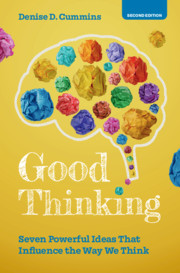Book contents
- Good Thinking
- Good Thinking
- Copyright page
- Dedication
- Contents
- Figures
- Tables
- Preface
- Part I
- Part II
- Eight Into the Weeds of Logic – How It’s Done
- Nine Into the Weeds of Moral Judgment – How It’s Done
- Ten Into the Weeds of Analogical Reasoning – How It’s Done
- Eleven Into the Weeds of Scientific Reasoning – How It’s Done
- Twelve Into the Weeds of Rational Decision-Making – How It’s Done
- Thirteen Into the Weeds of Game Theory – How It’s Done
- Fourteen Into the Weeds of Problem-Solving – How It’s Done
- Appendix A Answers to Insight Problems
- Answer Key to Quizzes
- Notes
- Index
Ten - Into the Weeds of Analogical Reasoning – How It’s Done
from Part II
Published online by Cambridge University Press: 18 February 2021
- Good Thinking
- Good Thinking
- Copyright page
- Dedication
- Contents
- Figures
- Tables
- Preface
- Part I
- Part II
- Eight Into the Weeds of Logic – How It’s Done
- Nine Into the Weeds of Moral Judgment – How It’s Done
- Ten Into the Weeds of Analogical Reasoning – How It’s Done
- Eleven Into the Weeds of Scientific Reasoning – How It’s Done
- Twelve Into the Weeds of Rational Decision-Making – How It’s Done
- Thirteen Into the Weeds of Game Theory – How It’s Done
- Fourteen Into the Weeds of Problem-Solving – How It’s Done
- Appendix A Answers to Insight Problems
- Answer Key to Quizzes
- Notes
- Index
Summary
An analogy is a relational similarity. Analogies are objects or events that are isomorphic, that is, they have structures in common. Two objects or events are not considered analogs of each other because they refer to the same thing, but because the relationships among their components are the same. In Chapter 3, we saw how former Federal Reserve Chairman Ben Bernanke justified bailing out the finance industry following its collapse in 2008 through use of an analogy: Even if an irresponsible neighbor set fire to his house, we need to put out the fire in order to prevent the fire from spreading to other houses in the neighborhood. A burning house has nothing physically in common with a failing bank. But at a deeper level of analysis, they describe similar relations among their components: A burning house is in danger of physical collapse, and poses a threat to neighboring houses. A failing bank is in danger of financial collapse, and poses a danger to other banks. More importantly, both require intervention if the collapse is to be prevented.
- Type
- Chapter
- Information
- Good ThinkingSeven Powerful Ideas That Influence the Way We Think, pp. 220 - 229Publisher: Cambridge University PressPrint publication year: 2021



